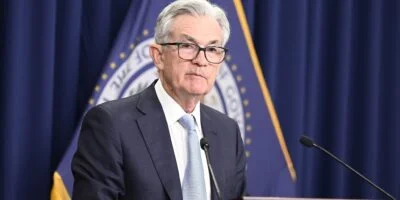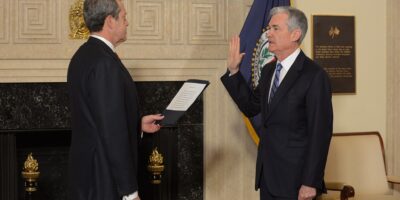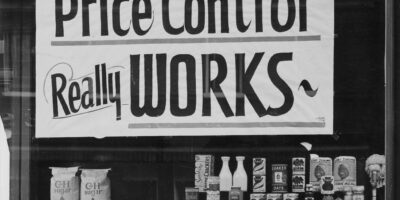Gold and Free Banking versus Central Banking

In spite of the officially declared “independence” of the Federal Reserve from the immediate political control of either Congress or the White House, America’s central bank is, nonetheless, a branch of the U.S. government that is responsible for setting monetary policy, overseeing a variety of banking regulations, and influencing market interest rates. As a result, politics is always present when it concerns the Federal Reserve, as witnessed in the nomination of Dr. Judy Shelton to serve on the central bank’s board of governors.
Dr. Shelton has become a lightning rod for angry opposition, not only due to Donald Trump, who as president of the United States nominated her to fill one of the seven slots on the Federal Reserve’s Board of Governors, but the fact that she has long been a public and vocal advocate for a return to some version of the gold standard as an “anchor” for limiting discretionary policies by the central bank.
Most academic and policy-oriented economists apparently are both flabbergasted and fearful that if she were to serve on the Fed board, she might actually attempt to limit the virtually unrestrained latitude the central bank currently has to seemingly create money and bank credit in practically any quantity, and, in the process, influence the level of interest rates at which banks make money available for borrowing purposes.
What is clearly horrifying to so many in the wide mainstream of the economics profession is the notion of a check on the powers and prerogatives of what amounts to America’s system of monetary central planning. But that is the very point of a commodity-based monetary system such as a gold standard, to limit abuse of the monetary printing press. Given an established redemption ratio between bank notes and deposit accounts for a quantity of gold on deposit in banks; given reserve requirements on checking and other forms of bank deposits; given an established rule of the right of free import and export of gold between one’s own country and the rest of the world; and assuming that the political authority with responsibility over the country’s monetary system does not interfere with these conditions and rules, then political influences on the value and quantity of money would be minimized.
The Gold Standard in Practice
In the second half of the 19th century most of the major countries of the world put into place national monetary systems based on gold. By the fact that such a large number of countries had each linked their respective currencies to gold at some fixed rate of redemption in this manner, there emerged an international gold standard. A person in any one of those countries could enter any number of established, authorized banks and trade in a certain quantity of bank notes for a stipulated sum of gold, in the form of either coin or bullion. He could transport that sum of gold to any of the other gold-based countries and readily convert it at a fixed rate of exchange into the currency of the country to which he had traveled.
Why did governments recognize and (with occasional exceptions) follow the rules of the gold standard through most of this part of the 19th century? Because the gold standard was considered an integral element in the reigning political philosophy of the time, classical liberalism. As the German free-market economist Wilhelm Röpke (1899-1966) explained in International Order and Economic Integration (1959):
“The international ‘open society’ of the nineteenth century was the creation of the “‘liberal spirit’ in the widest sense . . . [guided by] the liberal principle that economic affairs should be free from political direction, the principle of a thorough separation between the spheres of government and of economy . . . The economic process was thereby removed from the sphere of officialdom, of public and penal law, in short from the sphere of the ‘state’ to that of the ‘market,’ of private law, of property, in short to the sphere of ‘society.’” (p. 75)
At the same time, said Röpke,
“This [liberal] principle also solved an extremely important special problem of international integration . . . i.e., the problem of an international monetary system . . . in the form of a gold standard . . . It was a monetary system which rested upon the structural similarity of the national systems, and which made currency dependent, not upon political decisions of national governments and their direction, but upon the objective economic laws, which applied once a national currency was linked to gold . . . But it was at the same time a phenomenon with a moral foundation . . . The obligations, namely, which a conscientious conformity with the rules of the gold standard imposed upon all participating countries formed at the same time a part of that system of written and unwritten standards which . . . comprised the [international] liberal order.” (pp. 75-76)
In the 19th century, the ruling idea, for the most part, had been liberty. The wealth of nations was seen as arising from individual freedom in a social order respecting private property in the means of production. The relationships among men, it was believed, should be based on voluntary exchange for mutual benefit. Just as there were no inherent antagonisms among men in a free market within the same nation, there were no inherent antagonisms among men living in different nations. The mutual gains from trade could be expanded by extending the principle of division of labor to a global scale. If men were to benefit from those possibilities, a stable, sound, and trustworthy monetary order had to assist in the internationalization of trade. Gold was considered the commodity most proven through the ages to serve that function. And preservation of the gold standard, therefore, was given a prominent place among the limited duties assigned to the classical-liberal state in that earlier era.
There also was, in general, a greater humility through a good part of the 19th century among those who constructed and implemented various government economic policies. There was a general agreement with Adam Smith’s (1723-1790) observation in The Wealth of Nations (1776) that “the statesman, who should attempt to direct private people in what manner they ought to employ their capitals, would not only load himself with a most unnecessary attention, but assume an authority which could safely be trusted, not only to no single person, but to no council or senate, and which would nowhere be so dangerous as in the hands of a man who had the folly and presumption enough to fancy himself fit to exercise it.” (Cannan ed., 1904, pp. 423)
The Gold Standard was a Government-Managed Monetary System
The classical liberals were deeply suspicious of government abuse of the printing press. They believed that only a monetary system under which all bank-issued notes and other deposit claims were redeemable on demand for gold could act as a sufficient check against the abuse and debasement of a currency.
However, even in the high-water mark of classical liberalism in the 19th century, practically all advocates of the free market and free trade believed that money was the one exception to the principle of private enterprise. The international monetary order of that earlier century, of which Wilhelm Röpke spoke in such glowing terms, was nonetheless the creation of a planning mentality. The decision to “go on” the gold standard in each of the major Western nations was a matter of state policy.
A central-banking structure for the management and control of a gold-backed currency was established in each country by its respective government, either by giving a private bank the monopoly control over gold reserves and issuing banknotes or by establishing a state institution assigned the task of managing the monetary system within the borders of a nation. The United States was the last of the major Western nations to establish a central bank, but it finally did so in 1913.
Central-banking authorities were given the power and responsibility to manage the gold reserves at their disposal and the quantity of notes and other bank deposit claims outstanding to maintain the soundness of the monetary system and to counteract various short-term fluctuations in the national currency’s foreign exchange rate, the balance of payments, and the quantity of financial credit available in the country’s economy. Their policy “tools” included manipulation of short-term interest rates and the buying and selling of private-sector bills of trade and securities.
While the goals for monetary policy may have been considered modest and limited in the eyes of the classical liberals of the 19th century, it remained a fact that the monetary system was a subject for national government policy. In an era of relatively unrestricted free-market capitalism, money and the monetary system were a “nationalized industry.” And as such, even most of the advocates of economic liberty argued for what was in effect monetary socialism and monetary central planning. They failed to call for and defend the privatization of the most important commodity in a market economy – the medium of exchange.
Lost Innocence About Money, and Changing Monetary Goals
What they forgot was that once a government has control and responsibility for the monetary system within a country, little is outside the power of that government to influence and manipulate. This was clearly stated by a prominent German economist, Gustav Stolper (1888-1947), who, while a refugee in the United States from war-torn Europe during the Second World War, argued in, This Age of Fable (1942):
“Hardly ever do the advocates of free capitalism realize how utterly their ideal was frustrated at the moment the state assumed control of the monetary system . . . A “free” capitalism with government responsibility for money and credit has lost its innocence. From that point on it is no longer a matter of principle but one of expediency how far one wishes or permits governmental interference to go. Money control is the supreme and most comprehensive of all government controls short of expropriation.” (p. 59)
As a result, when economic collectivism, socialism, and interventionism gained popularity and power in the early decades of the 20th century, money was the one area in which the central planning ideal was already triumphant. For more than a hundred years, now, in the United States, it had been taken for granted that the state should have either direct or indirect monopoly control over the supply of money in the market.
In the slightly over 100 years since the First World War, the goals assigned to monetary central planning have changed, but the instrument for their application remained the same: central bank management of the money supply. In the 1920s, Federal Reserve policy was heavily focused on “price level” stabilization; its result was generating a variety of imbalances between saving and investment that set the stage for the Great Depression.
Beginning in the 1930s, under the growing influence of Keynesian Economics, the goal was to influence the levels of aggregate employment and output in the economy. After the disastrous experience with Keynesian-generated “stagflation” in the 1970s – a combination of significantly rising prices and persistently high unemployment – the monetary authorities in the 1980s and 1990s focused on slowing down and “controlling” inflation. In the late 1990s, the Federal Reserve switched back to a more “activist” monetary policy that fed the excesses of the “high tech” bubble that went bust shortly after the turn of the new century. (See my eBook, Monetary Central Planning and the State [2016].)
Then, in 2003, fearful of hypothetical “deflationary” forces, the Federal Reserve went on a policy of monetary expansion that created the monetary and credit wherewithal that produced the housing and investment and consumer spending boom that dramatically burst in 2008 – and from which it took nearly a decade to recover, especially in terms of employment, during which monetary expansion continued anew under the phraseology of “quantitative easing” for the ten years following the financial crisis. (See my article, “Ten Years On: Recession, Recovery, and the Regulatory State”.)
Now, in the face of coronavirus crisis, the Federal Reserve has all but given up any notions of monetary restraining limits, as it has expanded the money supply in a matter of a handful of months since the beginning of 2020, making a huge amount of this money available not only to finance the more than $2 trillion of additional federal government spending, but to provide ready cash to households, private enterprises, financial markets, and state and local governments. In fact, from mid-March into June of 2020, the Federal Reserve increased its portfolio of securities and other assets from $3.9 trillion to $6.1 trillion; a nearly 57 percent increase in a matter of just three months.
At the same time, interest rates have been pushed down to virtually zero by Federal Reserve policy. It has been totally forgotten that interest rates are supposed to serve the same function that all other prices in a functioning market economy: to tell people the relationship between supply and demand. When interest rates are reduced to nearly zero by the monetary central planners, how can people have any notion of the actual amount and availability of savings, and how can private-sector borrowers make any rational economic calculation about what is a real market-based cost of borrowing relative to a prospective profitability of an investment? (See, my article, “Interest Rates Need to Tell the Truth”.)
This has been made possible due to the fact that throughout the last century, governments – including the United States government – loosened the limits that gold had placed on the ability of central banks to expand the money supply and manipulate the amount of credit created and issued through the banking system to facilitate changing monetary and fiscal goals. For decades, now, governments – including the United States government – have completely eliminated this “break” on their discretionary monetary policy by ending any legal connection between the paper currencies they control and gold.
The world economy operates in an economic environment of paper monies under the monopoly control of central banks.
Central Banking is a Form of Central Planning – With the Same Defects
One of the primary benefits of economic freedom is that it decentralizes the negative effects that may arise from ordinary human error. Every one of us makes decisions that we hope will produce outcomes we desire.
Yet, the actual outcomes from our actions often fail to match up to the hopes that motivated them. A businessman who misreads market trends in planning his private company’s production and marketing strategies may experience losses that require him to cut back his activities, resulting in some of his employees’ losing their jobs, and in resource suppliers’ experiencing fewer sales because the loss-suffering businessman reduces his orders for what they have for sale.
But the negative ripple effects from his entrepreneurial mistakes are localized within one corner of the overall market. Other sectors of the market need not be directly penalized or subject to the unfortunate effects of his poor judgment. Profit-making enterprises can freely go about their business hiring, producing, and then selling the goods that they have more correctly anticipated the consuming public actually desires to buy.
Under government central planning, however, errors committed by the central planners are more likely to have an impact on the economy as a whole. Every sector of the economy is directly interlocked within the centrally planned blueprint for the allocation of resources, the quantities of different goods and services to be produced, and the distribution of the output to the consuming public.
Centralized failures in resource use or production decisions more directly affect every sector of the economy, since nothing can happen in any of the government-run industries independently of how the central planners try to fix their mistakes. Everyone more directly feels the consequences of the central planners’ errors and must wait for those planners to devise a revised central plan to correct the problem.
Central Banking’s Economy-Wide Impacts from Policy Mistakes
Monetary central planning suffers from the same sort of defect. Changes in the money supply emanate from one central source and are determined by the monetary central planners’ conceptions of the “optimal” or desired quantity of money that should be available in the economy. Their central decisions influence the pattern of interest rates (at least in the short run) and the market structure of relative prices and inevitably bring about changes in the general value, or purchasing power, of the monetary unit. The monetary central planners’ policies work their way through the entire economy, bringing about a cycle of an inflationary boom followed by general economic downturn or even depression.
Halting an inflation and bringing an unsustainable boom to an end depends upon the monetary central planners’ discovery that things “may have gone too far” and a decision by them to reverse the course of monetary policy. Many, if not most, sectors of the market will then have to modify and correct investment, production, and employment decisions that had been made under the false, inflationary price signals the central planners’ monetary policy has artificially created. Capital, wealth, and income spending patterns in the market will have been misdirected and partly wasted because of the errors committed by the monetary central planners.
The opponents of central banking have argued that the occurrence of such errors would be less frequent and discovered more quickly under an alternative system of competitive free banking. Any private bank that “over-issued” its currency would soon discover its mistake through the feedback of a loss of gold or other reserves through the interbank clearing process and withdrawals by its depositors. The bank would realize the necessity of reversing course to ensure that its gold- and other-reserve positions were not seriously threatened and avoid the risk of losing the confidence of its own customers because of heavy withdrawals by depositors.
Moreover, the effect of such a private bank’s following a “loose” and “easy” monetary policy would be localized by the fact that only its banknotes and check money would be increasing in supply because of the additional spending of those to whom that bank had extended additional loans. It could neither force an economy-wide monetary expansion throughout the entire banking system nor create an economy-wide price-inflationary effect. Any negative consequences, while being unfortunate, would be limited to a relatively narrow arena of market decisions and transactions.
Free Banking and the Benefits of Market Competition
One of the strongest arguments that advocates of the free market have made over the last 200 years has been to point out the benefits of competition and the harmfulness of government-supported monopoly. In a competitive market, individuals are at liberty to creatively transform the existing patterns of producing and consuming in ways they think will make life better and less expensive for themselves and other members of society as a whole.
Wherever legalized monopoly exists, the privileged producer is protected from potential rivals who would enter his corner of the market and supply an alternative product or service to those consumers who might prefer it to the one marketed by the monopolist. Innovation and opportunity are either prevented or delayed from developing in this politically guarded sector of the economy. Production methods remain unchanged or are modified only with great delay. Product improvements are slow in being developed and introduced. Incentives for cost efficiencies are less pressing and, when utilized, are often only sluggishly passed on to consumers in the form of lower sale prices.
Those who have the vision and daring to enter the market and successfully innovate and create newer or better products than the existing suppliers are offering are stymied or blocked from doing so in the protected sectors of the economy. They are forced to apply their entrepreneurial drive in less profitable directions or are dissuaded by the political restrictions from even attempting to do so. The product improvements they would have supplied to the consuming public remain invisible “might-have-beens” lost to society.
Furthermore, as Friedrich A. Hayek (1899-1992) especially emphasized, market competition is the great discovery procedure through which it is determined who can produce the better product with the most desired features and qualities and at the lowest possible price at any given time. It is the peaceful market method through which each participant in the social system of division of labor finds his most highly valued use as judged by the relative pattern and intensity of consumer demand for the various goods supplied. Competition’s dynamic quality is that it is a never-ending process. In the arena of exchange, every day offers new opportunities and allows entrepreneurs and innovators to create new opportunities that they are free to test on the market in terms of possible profitability.
Every political restriction or barrier placed in the way of competition, therefore, closes the door on some potential creativity, risk-taking, and entrepreneurial discovery of more efficient and rational uses of men, materials, and money in the interdependent and mutually beneficial relationships of market specialization and cooperation. The choice is always between market freedom and political constraint, between the competitive process and governmentally created monopoly.
This general argument in favor of market competition and against politically provided monopoly is no less valid in the arena of money and banking. The participants in a free market monetary system would have the liberty to choose the money they find most advantageous to use; or, instead, government can impose the use of a medium of exchange on society and monopolize control over its supply and value. The benefit from market-chosen money is that it reflects the preferences and uses of the exchange participants themselves.
Participants in the market process will sort out which commodities offer those qualities and characteristics most useful and convenient in a medium of exchange. As the Austrian economists persuasively demonstrated, while money is one of those social institutions that are “the results of human action but not of human design,” it nonetheless remains the spontaneous composite outcome of multitudes of individual choices freely made by buying and selling in the marketplace.
“Political Money” vs. Market-Based Money and Banking
The alternative is what the American economist Francis A. Walker (1840-1897) referred to in his Political Economy (1887) as “political money.” Political money is one that the government determines shall be used as money and whose supply “is made to depend upon law or the will of the ruler.” He warned that under the best of circumstances the successful management of a government-controlled money would “depend upon an exercise of prudence, virtue and self-control, beyond what is reasonably and fairly to be expected of men in masses, and of rulers and legislators as we find them.” Governments would, in the long run, always be tempted to abuse the printing press for various political reasons. (pp. 352-353)
But besides the dangers of political mischief, the fact is that the government monetary monopoly prevents the market from easily discovering whether, over time, market participants would find it more advantageous to use some particular commodity or several alternative commodities as different types of media of exchange to serve changing and differing purposes. The “optimal” supply of money becomes an arbitrary decision by the central monetary monopoly authority rather than the more natural market result of the interactions between market demanders desiring to use money for various purposes and market suppliers supplying the amount of commodity money that reflects the profitability of mining various metals and minting them into money-usable forms.
But commodity money, as history has shown, has its inconveniences in everyday transactions in the market. There are benefits from financial depositories for purposes of safety and lowering the costs of facilitating transactions. But what type of financial and banking institutions would market participants find most useful and desirable under a regime of money and banking freedom? The answer is that we don’t know at this time precisely because government has monopolized the supplying of money; and it imposes, through various state and federal regulations, an institutional straitjacket that prevents the discovery of the actual and full array of preferences and possibilities that a free market in monetary institutions might be able to provide and develop over time.
The increasing globalization of commerce, trade, and financial intermediation during the last several decades has certainly demonstrated that there is a far greater range of possibilities that market suppliers of these services could provide and for which there are clear and profitable market demands than traditionally thought 20 or 30 years ago.
But even in this more vibrant global competitive environment, it remains the case that whatever options have begun to emerge have done so in a restrictive climate of national and international governmental regulations, agreements, and constraints. Governments clearly wish to crush or control market-originating cyber-currencies, for instance, that threaten to be out of their grasping reach.
Depositors Would Decide Reserve Requirements Under Free Banking
Suppose that monetary and banking freedom were established. What type of banking system would then come into existence? Some advocates of monetary freedom have insisted that a free banking system should be based on a 100 percent commodity money reserve. Others have argued that a free banking system would be based on a form of fractional-reserve banking, with the competitive nature of the banking structure serving as the check and balance on any excessive note issue by individual banks.
Until monetary and banking freedom is established, we have no way of knowing which of the two alternatives would be the most preferred. This is for the simple reason that under the present government-managed and government-planned monetary and banking system, market competition is not allowed to demonstrate which options suppliers of financial intermediation might find profitable to offer and which options users of money and financial institutions would decide are the ones best fitting their needs and preferences.
Given the diversity in people’s tastes and preferences, the differing degrees of risk people are willing to bear for a promised interest return on their money, and the variety of market situations in which different types of monetary and financial instruments might be most useful for certain domestic and international transactions, it probably would be the case that a spectrum of financial institutions would come into existence side by side. At one end of this spectrum might be 100 percent reserve banks that guaranteed complete and immediate redemption of all commodity money deposits, even if every depositor were to appear at that bank within a very short period of time.
Along the rest of the spectrum would be various fractional-reserve banks at which lower or no fees would be charged for serving as a warehousing facility for deposited commodity money. Their checking accounts might offer different interest payments depending on the fractional-reserve basis on which they were issued and on the degree of risk or uncertainty concerning the banks’ ability to redeem all deposits immediately under exceptional circumstances.
Some banks might offer both types: they might issue some bank notes and checking accounts that were guaranteed to be 100 percent redeemable on the basis of commodity money deposited against them; and they might issue other bank notes and checking accounts that, under exceptional circumstances, were not 100 percent redeemable at the same time.
And these banks might offer “clauses” stipulating that if any designated notes or checking accounts were not redeemed on demand for some limited period of time, the note and account holder would receive a compensating rate of interest for the inconvenience and cost to himself.
Whether most banks would be closer to the 100 percent reserve end of this spectrum or farther from it is not – and cannot be – known until the monetary and banking system is set free from government regulation, planning, and control. As long as the government remains as the monetary monopolist, there is just no way to know all the possibilities that the market could or would generate. Indeed, for all we know, the market might devise and evolve a monetary and banking system different from that conceived even by the most imaginative free-banking advocates.
Competition is thwarted by government monopoly money, and the creative possibilities that only free competition can discover remain invisible “might-have-beens.” How then can the existing system be moved towards a regime of monetary and banking freedom?
For a System of Monetary and Banking Freedom
The great tragedy of the 20th century was the arrogant and futile belief that man can master, control, and plan society. Man has found it difficult to accept that his mind is too finite to know enough to organize and direct his overall social surroundings according to an overarching design. The famous American journalist, Walter Lippmann (1889-1974), neatly explained the nature of this problem in his 1937 book, An Inquiry into the Principles of the Good Society:
“The thinker, as he sits in his study drawing his plans for the direction of society, will do no thinking if his breakfast has not been produced for him by a social process that is beyond his detailed comprehension. He knows that his breakfast depends upon workers on the coffee plantations of Brazil, the citrus groves of Florida, the sugar fields of Cuba, the wheat farms of the Dakotas, the dairies of New York; that it has been assembled by ships, railroads, and trucks, has been cooked with coal from Pennsylvania in utensils made of aluminum, china, steel, and glass. But the intricacy of one breakfast, if every process that brought it to the table had deliberately to be planned, would be beyond the understanding of any mind. Only because he can count upon an infinitely complex system of working routines can a man eat his breakfast and then think about a new social order. The things he can think about are few compared with those that he must presuppose . . . Of the little he has learned, he can, moreover, at any one time comprehend only a part, and of that part he can attend only to a fragment. The essential limitation, therefore, of all policy, of all government, is that the human mind must take a partial and simplified view of existence. The ocean of experience cannot be poured into the bottles of his intelligence…. Men deceive themselves when they imagine that they can take charge of the social order. They can never do more than break in at some point and cause a diversion.” (pp. 30-31)
Money is one of those institutions that owes its origin and early development to social processes beyond what individual minds could have fully anticipated or comprehended. But money’s evolution has been constantly “diverted” from what would have been its market-determined course by governments and political authorities that saw in its control an ability to plunder the wealth of entire populations.
Debasement and depreciation of media of exchange through monetary manipulation has been the hallmark of recorded history. To prevent such abuses and their deleterious effects, advocates of freedom supported the gold standard to impose an external check on monetary expansion. Paper money was to be “convertible,” redeemable on demand into gold by all banknotes and checking account holders at a fixed ratio of redemption.
But even this limit on government-managed money was eliminated in the 20th century by the hubris of the central planning mentality, under which money, too, was to be completely under the control of the monetary central planners as part of the vision of designing and directing the economic affairs of society.
The fact is that even if monetary policy could somehow be shielded from the pressures and pulls of ideological and special-interest politics, there is no way to successfully centrally manage the monetary system. Government can no more correctly plan for the “optimal” quantity of money or the properly “stabilized” general scale of prices than it can properly plan for the optimal supply and pricing of shoes, cigars, soap, or scissors.
The best monetary policy, therefore, is no monetary policy at all. The need for monetary policy would be eliminated by abolishing government monopoly control and regulation over the monetary and banking system.
As Austrian economist Hans Sennholz (1922-2007) once concisely expressed it, “We seek no reform law, no restoration law, no conversion or parity, no government cooperation: merely freedom…. In freedom, the money and banking industry can create sound and honest currencies, just as other free industries can provide efficient and reliable products. Freedom of money and freedom of banking, these are the principles that must guide our steps.”
An Agenda for Monetary Freedom
So, what steps might be undertaken to move the American economy in the direction of establishing a regime of monetary freedom? At a minimum, they should include the following:
- The repeal of the Federal Reserve Act of 1913, and all complementary and related legislation giving the federal government authority and control over the monetary and banking system.
- The repeal of legal-tender laws, that give government power to specify the medium through which all debts and other financial obligations, public and private, may be settled. Individuals, in their domestic and foreign transactions, would determine through contract the form of payment they mutually found most satisfactory for fulfilling all financial obligations and responsibilities into which they entered.
- Repeal all restrictions and regulations on the free entry into the banking business and in the practice of interstate banking.
- Repeal all restrictions on the right of private banks to issue their own bank notes and to open accounts denominated in foreign currencies or in weights of gold and silver.
- Repeal of all federal and state government rules, laws, and regulations concerning bank-reserve requirements, interest rates, and capital requirements.
- Abolish the Federal Deposit Insurance Corporation. Any deposit insurance arrangements and agreements between banks and their customers and between associations of banks would be private, voluntary, and market-based.
In the absence of government regulation and monopoly control, a free monetary and banking system would exist; it would not have to be created, designed, or supported. A market-based system would naturally emerge, take form, and develop out of the prior system of monetary central planning.
What would be its shape and structure over time? What innovations and variety of services would a network of free, private banks offer to the public over time? What set of market-determined commodities might be selected as the most convenient and useful media of exchange? What types of money substitutes would be supplied and demanded in a free-market world of commerce and finance? Would many or most banks operate on the basis of fractional or 100 percent reserves?
There are no definite answers to these questions, nor can there be. It is deceptive to believe, as Walter Lippmann explained, that we could comprehend and anticipate all the outcomes that will arise from all the market interactions and discovered opportunities that the complex processes of the free society would generate. It is why liberty is so important. It allows for the possibilities that can only emerge if freedom prevails. It’s why monetary freedom, too, must be on the agenda for economic liberty in the 21st century.










